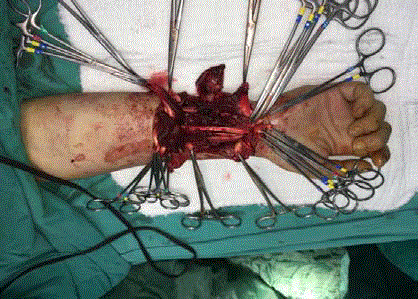Clinical Image
An Easy Tip for Tendon Repair in Spaghetti Wrist Injury
Demirdover C*, Ozturk FA, Yazgan HS and Vayvada H
Department of Plastic, Reconstructive, Aesthetic, and Hand Surgery, Dokuz Eylül University, School of Medicine,
Izmir, Turkey
*Corresponding author: Cenk Demirdover, Department of Plastic, Reconstructive, Aesthetic, and Hand Surgery, Dokuz Eylül University, Izmir, Turkey
Published: 27 Oct, 2017
Cite this article as: Demirdover C, Ozturk FA, Yazgan HS,
Vayvada H. An Easy Tip for Tendon
Repair in Spaghetti Wrist Injury. Clin
Surg. 2017; 2: 1699.
Clinical Image
Multicomponent soft tissue injuries of the wrist, also known as “Spaghetti Wrist Injuries” occur between the distal wrist crease and the flexor musculotendinous junctions involving at least three completely transected structures, including at least one nerve and often an artery [1]. There is a total of 16 functional structures in the volar wrist; twelve of which are flexor tendons, along with 2 arteries and 2 nerves to Since vascular and nerve repair require microsurgical intervention, tendon repair should often be performed initially [2]. In patients with multiple flexor tendons lacerations, the need for re-checking proximal and distal ends of each tendon before repair takes time. In our clinic, we use a tagged surgical forceps system. There are two pairs of each forceps, one for the proximal end and one for the distal end, each labelled 1 to 5. We use straight-tip forceps for FDS tendons and curved-tip forceps for FDP tendons (Figure 1). Once all the tendons are determined and meticulously clamped to the forceps, then we start tendon repair from deep to superficial ones. We believe that this system reduces surgical time and gives the surgeon to recheck the tendons if necessary.
Figure 1
References
- Puckett CL, Meyer VH. Results of treatment of extensive volar wrist lacerations: the spaghetti wrist. Plast Reconstr Surg. 1985;75(5):714-21.
- Bal S, Oz B, Gurgan A, Memis A, Demirdover C, Sahin B, Oztan Y. Anatomic and functional improvements achieved by rehabilitation in Zone II and Zone V flexor tendon injuries. Am J Phys Med Rehabil. 2011;90(1):17-24.

